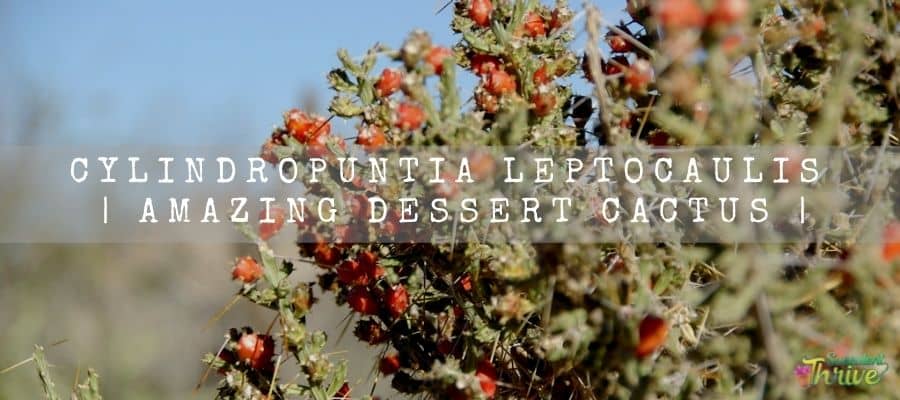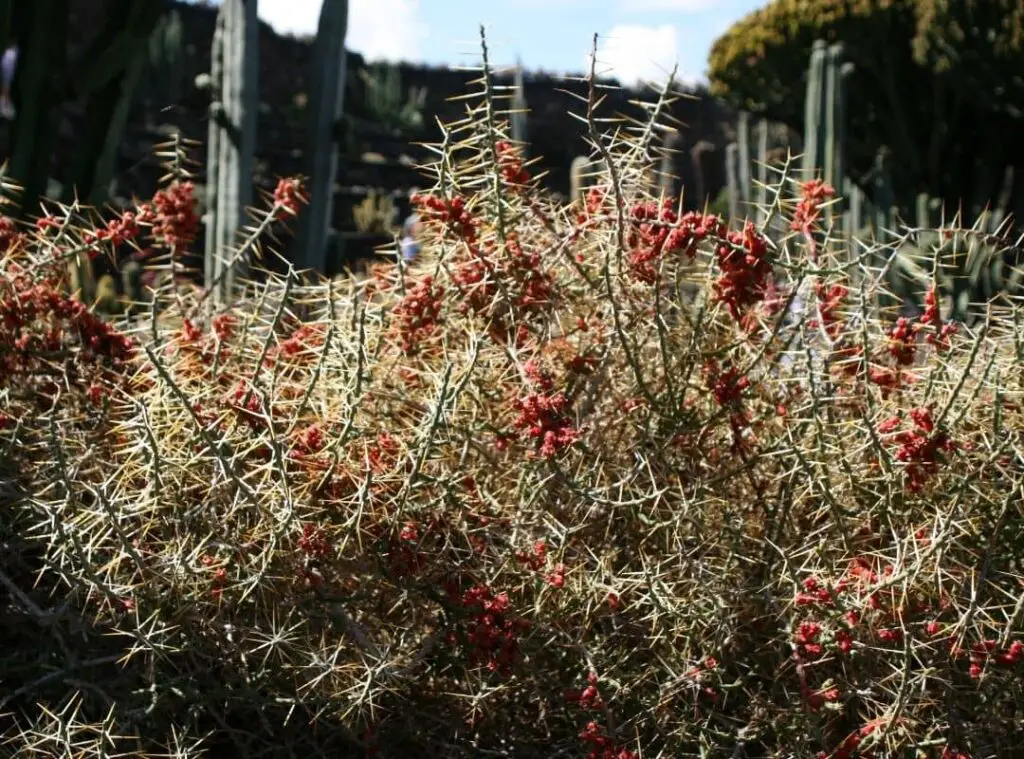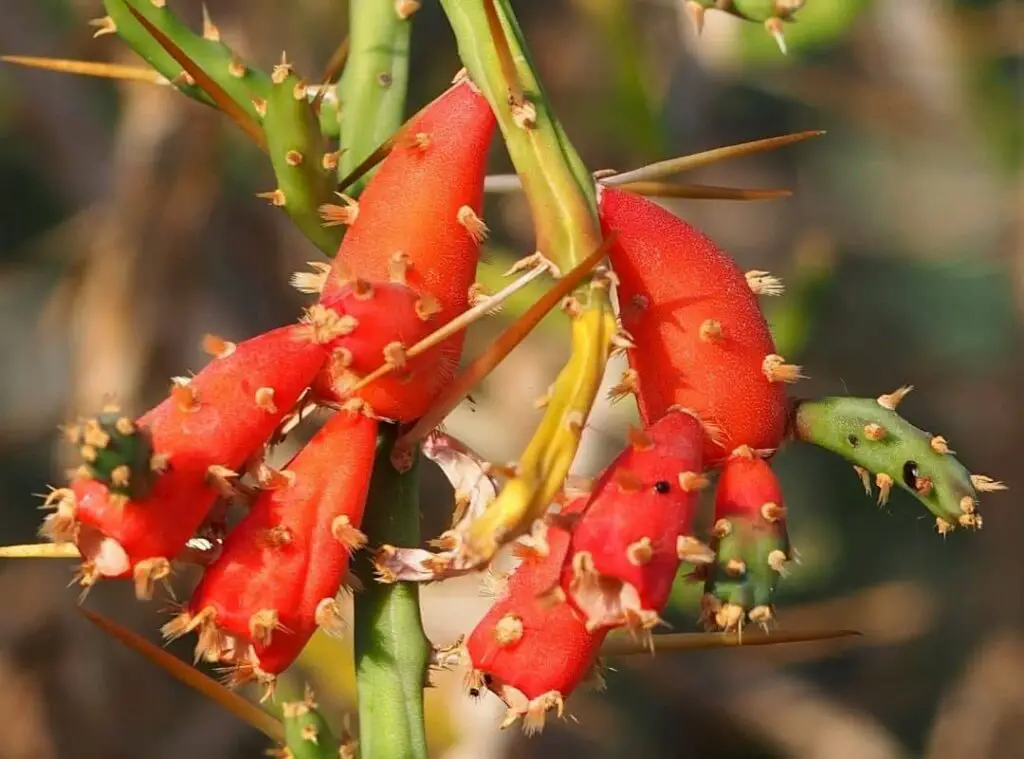I think Cylindropuntia leptocaulis is a fascinating succulent in the succulent cactus world. They are indigenous to Mexico. They also require easy maintenance, and due to that, many people like to grow them. So, if you are one of them and want to learn more about these plants, I strongly advise you to read this article.

One look care guide
| Botanical Name | Cylindropuntia leptocaulis |
| Common Name | The desert Christmas cactus |
| Plant Type | Succulent / cactus |
| Mature Size | 2-5 feet in height |
| Sun Exposure | Full sunlight to partial shade |
| Soil Type | Well draining |
| Soil pH | Soil pH requirements: 6.1 to 6.5 (mildly acidic) 6.6 to 7.5 (neutral) 7.6 to 7.8 (mildly alkaline) |
| Bloom Time | Spring / autumn |
| Flower Color | Green, yellow |
| Hardiness Zones | USDA Zone 9b: USDA Zone 11: above 4.5 °C (40 °F). |
| Native Area | Mexico |
| Toxicity | Not recorded |
| Average price | 15 USD |
How do I identify Cylindropuntia leptocaulis?
The Cylindropuntia leptocaulis plants can be identified by their sizes first. In fact, they would grow to be about 2-5 feet tall and would grow as shrubs. They would consist of slender branches. Further, those branches are narrow and consist of spines as well. Cylindropuntia leptocaulis develops new growth in dark green. When they reach maturity, they will turn a pale tan color. In fact, they would develop a scaly bark once they matured.
Cylindropuntia leptocaulis leaves are tiny, and they usually fall in every growing season. Those leaves would be green in color and tend to take an awl shape. They would be 12 mm in length. In terms of the flowering of the plants, they would produce flowers in green and yellow colors. Those flowers would be 2 cm in size, and they would arise in the late afternoon.
Further, these plants emerge with flowers in bronze as well. They would transform into some fruit item once they finished flowering. They would usually arise while clinging to the stem during the winter. Either red or purple in color, and fleshy to the touch. Moreover, they would tend to take a stout shape as well. Those fruits are edible. Cylindropuntia leptocaulis stems would be 5-8 cm in diameter.
Size of the plant
Cylindropuntia leptocaulis plants would rise up to 2-5 feet in height.
Growth rate
Cylindropuntia leptocaulis plants are slow growing plants.
How do you take care of Cylindropuntia leptocaulis?
Light Requirement
Full sun to partial sun would work well with the Cylindropuntia leptocaulis plants. If we consider the indoor grown Cylindropuntia leptocaulis plants, they will prefer to have bright sunlight. On the other hand, when you grow them outdoors, they would thrive well with morning full sunlight and with partial sunlight in the intense hours of the day, especially during summer.
I recommend that you protect the plants from direct sunlight during the hot summer months, unless you want to risk scorching them. If you think your indoor-grown Cylindropuntia leptocaulis plants are lacking adequate sunlight, you could consider placing grow lights closer to the plants. They would supplement the necessary sunlight levels as well as the heat.
Temperature and humidity
Cylindropuntia leptocaulis plants prefer to have warmer temperatures during their growth. In fact, they hate colder temperatures. If you accidentally expose them to colder temperatures, it will negatively impact the well-being of the plants and cause their health to deteriorate. However, if you planted them in containers and placed them outdoors, you need to bring them indoors to protect them from such unhealthy winter conditions.
Having said that, they can tolerate winter conditions up to -2 degrees Celsius for some time when they grow in the wild. However, when you cultivate them, I recommend not exposing them to temperatures below 0 degrees Celsius at all. They can withstand high temperatures during the summer but not lower temperatures during the winter. Additionally, do not expose them to high humidity levels as well. These are quite vulnerable to diseases such as root rot, and if you expose them to such conditions, it would result in root rot.
Is it cold hardy?
Cylindropuntia leptocaulis plants are a little cold hardy up to -2 degrees Celsius.
Growth Zone
Cylindropuntia leptocaulis grows well in USDA hardiness Zone 9b: USDA Zone 11b:

Watering Requirement
Cylindropuntia leptocaulis plants will perform well with moderate watering. These are drought tolerant plants, and they will not tolerate overwatering at any given time. In fact, overwatering could be the biggest mistake that you make when taking care of these precious plants.
I suggest watering them regularly during summer and minimize watering during winter. However, whenever you water them, you need to check whether their soil is dry from the previous watering session and only then you need to proceed with watering.
Soil Requirement Type / pH
Cylindropuntia leptocaulis plants perform well in a fast-draining soil mix. As aforesaid, they are susceptible to root rot, and overwatering and excessive humidity levels could result in such conditions. As such, it is critically important that you choose a substrate that has excellent drainage so that excess water will not be retained within the soil medium.
Cylindropuntia leptocaulis plants grow in sandy or gravelly soil, and you need to mimic the same conditions when you cultivate them as well. I recommend growing them in a commercially made succulent / cactus soil mix, as they have excellent drainage and good aeration as well.
Pot size Potting and Repotting
Terracotta pots or unglazed pots would be perfect for the healthy growth of the Cylindropuntia leptocaulis plants. Those pot materials are high in porosity, which will help the excess moisture evaporate rapidly without remaining in the pot. In addition to that, the selected pot needs to have generous drainage as well. In terms of repotting the Cylindropuntia leptocaulis plants, you need to do it less often, perhaps once every two years, since these are slow growing plants.
However, spring would be the best season to conduct repotting, and you can consider repotting them if their roots are growing in a cramped manner. When you repot the plants periodically , it will provide fresh growing conditions, which will allow them to gain fresh nutrients as well. I recommend skipping water for two weeks right after you report them. Cylindropuntia leptocaulis has spines on its foliage, and it is best to protect yourself before interacting with the plants unless they may injure you.
Where to Plant
Ensure that you plant them in a spot where they can gain sufficient sunlight. Cylindropuntia leptocaulis plants need sufficient sunlight levels to grow well, and you need to be mindful of this factor when choosing a place to plant them. Additionally, you need to select a growing medium that has excellent drainage when you cultivate them.
Fertilizer and time of year
Consider feeding the Cylindropuntia leptocaulis with a standard cactus fertilizer. You can also use a water-soluble fertilizer or granular fertilizer. I recommend feeding them during their active growing season, as it will help the plants grow vigorously and healthily. On the other hand, never feed them when they are dormant.
Flower
Cylindropuntia leptocaulis blossoms in green to yellow colors. Further, they may carry red tips as well. Those flowers would be 5-8 mm in size. You could spot them in bloom in spring and sometimes in autumn as well.

Dormancy
Cylindropuntia leptocaulis are winter dormant plants.
Toxicity
There is no record of toxicity of this plant. Therefore be careful handling them. Do not let your kid or pet.
Common bugs and illnesses
Cylindropuntia leptocaulis may suffer from regular pests’ attacks. For example, pests such as mealybugs, aphids, and scale may be troublesome for the plants. If they find favorable conditions for them, they will feel welcome and end up invading the plants in the end. In addition to that, overwatering could also result in root rot on these plants.
It could be so dangerous as chances are that you may even lose the plants due to root rot. Having said that, if you ensure that you practice the right growing tips, it is very unlikely that the plants will go through these conditions.
Special Care tips
Cylindropuntia leptocaulis requires easy maintenance from you and all you need to ensure is that you fulfill their basic growing care treatments properly. To sum up, water them moderately, provide a well-draining soil mix and expose them for sufficient sunlight.
Benefits
Cylindropuntia leptocaulis are great picks for desert gardens and for xerophytes as well. Further they would be great picks to use for indoor gardening too. Further Cylindropuntia leptocaulis fruits are used for consumption as well.
How to propagate Cylindropuntia leptocaulis?
You may propagate Cylindropuntia leptocaulis by using the seeds and stem divisions. However, what you could ideally do is use their stem segments and place them in a loose, well-draining soil mix. You could get faster results with the stem propagation method.
Conclusion
To wind up, Cylindropuntia leptocaulis are such a versatile set of plants which would perform well if you look after them properly. The ability to produce beautiful flowers is one more added advantage of having these beautiful plants. So, I hope now you are all set to start growing these spectacular plants.
Read Next : Epithelantha Micromeris | A Beautiful Fur Ball |
